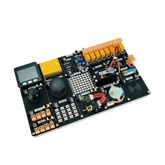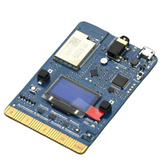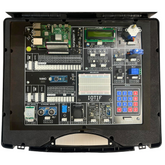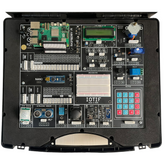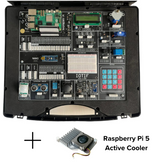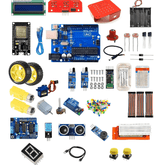How Does 5G Technology Enhance the Internet of Things (IoT)
Summary
In our latest blog, we delve into the dynamic synergy between 5G technology and the Internet of Things (IoT). Beginning with a primer on IoT, we uncover its transformative potential in connecting devices worldwide. Next, we unravel the intricacies of 5G technology, spotlighting its blazing speed and low latency. But the real magic unfolds as we explore how 5G supercharges IoT, revolutionizing industries and daily life. Yet, amidst the excitement, we address the challenges that arise and unveil compelling applications of 5G-enabled IoT. Join us on this journey of innovation and connectivity. Don't miss out!
Hey there! Have you ever wondered about the magic behind smart homes, self-driving cars, or even wearable health monitors?
Well, it's all thanks to something called the Internet of Things, or IoT for short. It's the tech that connects our devices to the internet, making them smarter and more efficient. But now, there's a new tech on the block – 5G technology. It's super-fast and promises to take IoT to the next level.
In this blog, we'll explore how 5G is enhancing IoT, the challenges it's overcoming, and the incredible applications it's enabling. So, buckle up and get ready to dive into the exciting world of 5G-enabled Internet of Things!

What is IoT?
The Internet of Things (IoT) is a network of connected devices and technology facilitating communication between these devices and the cloud. It's made possible by advances in technology, like inexpensive computer chips and high-bandwidth telecommunications which allow billions of devices to communicate with each other and the cloud.
IoT allows everyday objects like toothbrushes and vacuum cleaners to automobiles and industrial machines, to collect data and respond intelligently.
Advancements in miniaturization have made IoT devices more accessible. Modern microcontrollers allow even small objects like light switches to connect to the internet. This integration of everyday objects with the internet forms the backbone of IoT, changing how we interact with our environment.
What is 5G Technology?
5G technology or the fifth generation of mobile network technology represents the latest advancement in mobile network standards from 1G to 4G. It's designed to link not only people but also machines, objects, and devices globally.
With 5G you can expect higher multi-Gbps peak data speeds, ultra-low latency, enhanced reliability, massive network capacity, increased availability, and a more consistent user experience.
How Does 5G Technology Enhance the Internet of Things (IoT)?
5G technology is going to change how the Internet of Things (IoT) works. As 5G networks become more common, we'll have faster and more reliable connections. This will transform how we use technology and interact with the digital world.
Here are 7 ways that 5G Technology Enhance the Internet of Things (IoT)
High Speed Data Transfer:
IoT devices need fast data transfer to work efficiently. 5G technology makes this happen by using higher frequency bands, which means data can be sent quickly, even large amounts of it. This speed is important in fields like healthcare.

For instance, wearable IoT devices can instantly send important health data, helping healthcare providers react fast in emergencies. Basically, 5G makes IoT devices work better, especially in situations where quick data transfer is crucial.
Lower Latency:
Latency means the delay in data transmission and response and it is a critical factor in IoT performance, especially in real-time applications like the Industrial Internet of Things (IIoT).

High latency can cause delays and safety issues. But with 5G, latency is reduced to just a few milliseconds which allows for instant decision-making and action. This improvement makes IoT systems more reliable and efficient, benefiting industries by enhancing safety and efficiency.
Seamless Integration in Smart Homes:
In smart homes, using IoT devices with 5G is super easy. Unlike older wireless connections, 5G links up almost instantly, making things much better and faster for users. This means that users can enjoy smoother interactions with their smart devices, such as thermostats, lights, security systems, and appliances.

For the 5G networks, lightning-fast responsiveness commands are executed very fast within a second or less. So, when you want to turn up the heat or dim the lights, it happens instantly, making your life at home a lot smoother and more convenient.
Security of IoT Devices:
As we use more IoT devices in our daily lives, the risk of them being hacked or compromised also goes up. Here 5G works by offering more secure connections and stronger data encryption.

This means that IoT devices can do their jobs without worrying too much about cyber threats.
With 5G's enhanced security measures in place now IoT devices can perform their tasks more effectively and give users peace of mind knowing their data is better protected.
Network Slicing:
Network slicing refers to one network that can be divided into separate virtual networks. This made possible by 5G technology. This feature of 5G technology, allows for the creation of virtual networks tailored to specific IoT needs.

This means IoT devices can operate within dedicated slices optimized for their requirements, such as low latency or high device connectivity.
For example, in industrial settings, IoT devices can benefit from slices prioritizing reliable communication for seamless operations. Overall, network slicing enhances the efficiency and scalability of IoT deployments across various industries.
Improve Coverage:
The rise of IoT applications faces a challenge with poor coverage which slows down their tasks. But with the arrival of 5G technology, this problem is expected to be resolved. 5G offers stronger and more reliable signals, greatly improving coverage for IoT devices.

Its faster speeds are particularly beneficial for IoT applications needing real-time data transmission, ensuring smooth communication and operation.
Endless Possibilities:
As 5G networks spread and more IoT devices are adopted, we expect a surge in connected devices and groundbreaking advancements. The combination of 5G and IoT offers smarter, interconnected environments that improve our quality of life, boost economic growth, and address societal issues.
This coming together opens up countless opportunities to transform industries, infrastructure, and everyday life, moving us closer to a more efficient, connected, and sustainable future.
IoT Challenges in 5G
- 5G requires closer tower placement due to shorter waves which leads to a higher number of cellular towers and affects IoT device connectivity in certain areas.
- 5G uses lots of Virtual components that increase security vulnerabilities. Increased security risks in 5G networks can pose significant threats to IoT device data integrity and privacy.
- Implementing 5G networks involves significant costs, including the adoption of compatible IoT devices.
- The need for higher frequencies in 5G networks brings challenges in spectrum allocation and availability. This scarcity might restrict the deployment of IoT devices that need specific frequency bands for communication.
- Like all wireless technologies, 5G emits high electromagnetic radiation. There are concerns about the potential health impacts of increased exposure to this radiation and especially with the proliferation of 5G infrastructure.
5G IoT Applications:

- Smart City: 5G enables real-time communication for traffic management, environmental monitoring, and public safety.
- Industrial Automation: Low latency and high-reliability support real-time control of factory automation, robotic manufacturing, and heavy machinery.
- Autonomous Vehicles: 5G facilitates real-time communication for safer self-driving cars and drones.
- Healthcare: 5G enables remote patient monitoring, telemedicine, and surgical robotics for efficient healthcare.
- Agriculture: 5G supports precision agriculture with real-time monitoring of soil, irrigation, and livestock for sustainable farming practices.
Conclusion:
The merging of IoT and 5G technology is reshaping our digital world, offering unmatched connectivity and innovation across sectors. IoT is changing daily life with interconnected devices, while 5G brings speed and reliability.
When we combine IoT and 5G, amazing things can happen. Imagine cars that drive themselves, cities that run more efficiently, and even better healthcare. But there are some problems to solve, like making sure everything works together and keeping everything safe.
Despite the challenges, the future looks exciting. As technology keeps growing, we'll see even more cool stuff that uses IoT and 5G to make our lives easier and our world smarter. By staying on top of these changes, we can all be part of creating a better future together.



